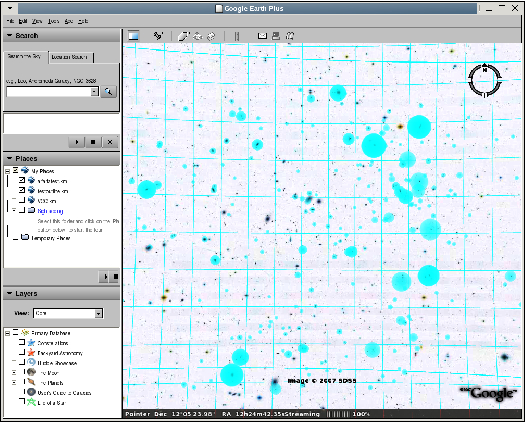
The Arecibo Legacy Fast ALFA Survey
NEW!
Check out the
ALFALFA Blog
What is ALFALFA, anyway?
On February 4, 2005, the Arecibo
Legacy
Fast ALFA Survey,
ALFALFA, began surveying the sky for faint cosmic radio signals from
hydrogen clouds in other galaxies and in intergalactic space.
Estimated to take 6-7 years to complete, ALFALFA is expected to detect
20,000 galaxies out to a distance of 750 million light years. If models
of the formation of galaxies and large scale structure are correct,
some of the objects detected by ALFALFA will be invisible to optical
telescopes because they contain few -- or no -- stars.
ALFALFA's principal science objective is the discovery
of "dark" galaxies: objects which consist largely of dark matter -- and in
this case, also hydrogen gas -- but not stars -- or at least,
not enough stars for them to be visible to optical telescopes. Dubbed
"stealth galaxies" by Science reporter Robert Irion, such objects are
believed to exist but remain undiscovered even in the neighborhood of our
own Milky Way Galaxy. The abundance of these "dark" galaxies, their
characteristics and location are key clues to our understanding
of how galaxies form and evolve throughout the universe.
In his recent News Focus summary in Science, Irion notes
that, of the radio searches for such objects, ALFALFA is the
"most ambitious program" (Science, 20 May 2005,
Vol 308, pp. 1104-6).
ALFALFA takes advantage of a new seven-pixel radio "camera" outfitted
on the world's largest radio telescope, the giant 300-meter diameter antenna
located in the hilly karst region of northwestern Puerto Rico.
Before the availability of this new device, the Arecibo
L-band Feed Array or
ALFA,
the Arecibo telescope
had essentially a one-pixel camera. An image could be constructed only by
pointing the telescope
painstakingly at one spot on the sky at a time, building up a two
dimensional image by many separate pointings. Because of its multi-pixel
feature, ALFA enables maps of the sky made with the big dish to be constructed
seven times faster, and thus, a hydrogen line survey of the extragalactic
sky visible to Arecibo now becomes feasible for the first time.
Following on the results of the
HIPASS
survey recently conducted with the
much smaller (64-meter diameter) Parkes telescope in Australia,
ALFALFA combines Arecibo's tremendous sensitivity
and beam size advantages with wide areal coverage to
increase dramatically the volume of the universe sampled to the
lowest HI masses. HI spectra provide redshifts, HI masses and rotational
widths for normal galaxies, trace the history of tidal events and provide
quantitative measures of the potential for future star formation.
ALFALFA aims to
provide publicly accessible, broad application, legacy data products that
will maximize the science fallout by enabling other astronomers to use them
beyond our own purposes.
ALFALFA is an open collaboration. Anyone with an interest in the science
that can be done with the ALFALFA dataset and the willingness to contribute
to the collective effort is welcome to join. Currently, the
ALFALFA team
consists of more than 50 astronomers from 34 institutions in 13 countries.
We are especially committed to the involvement of students at both the
graduate and undergraduate levels.
NEW! ALFALFA with Google Sky
A new feature to the Google Earth package, the Google Sky option
allows
users to interactively roam the night sky with mosaicked optical imaging
from the Sloan Digital Sky Survey
and Digitized Sky Survey from
POSS. Now, YOU can
explore the ALFALFA datasets, measurements, and spectra.
Download and open this KML file in Google Sky
and begin exploring the interactive radio Universe now!

Practical ALFALFA (designed for the ALFALFA undergrad team)
Links
Last modified Wed Jan 14 21:35:46 EST 2009 by martha


